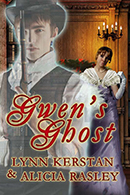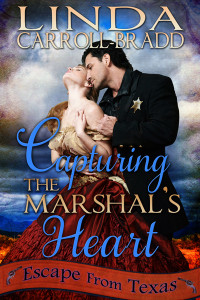Meet the hero and heroine of Gwen’s Ghost by Alicia Rasley and Lynn Kerstan, Book #5 in Regency Masquerades, six sparkling Regency romances in one ebook–currently 99 cents!
At the ballroom door…
Master of Ceremonies: Well, this is an interesting pair! They must not be a couple, I note. They don’t even seem to acknowledge each other, though they’ve arrived together. And they are not well-matched. The gentleman is impossibly handsome and impeccably dressed—perhaps too impeccably. I doubt I have ever witnessed a more opulent cravat arrangement. And the stickpin! My word.
The lady, well, she is properly attired. Quite properly. Quite primly. Though her lilac-gray silk gown already has rather a high neck, she has added a white fichu to conceal any glimpse of bare skin. Now she raises her assertive chin, and I can see a spray of freckles across her cheeks, and a militant light in her large hazel eyes.
He stretches out a hand. “Welcome to our ball. My lady. Sir.”
Lady and Gentleman: The lady gives a sniff, and after a moment the gentleman makes the introduction.
Gentleman: “This is Miss Gwendolyn Sevaric. And I am…” A pause. ” Jocelyn Vayle.”
Lady: “So you say.” She turns to the Master of Ceremonies. “He also says that he has no memory of his past. He took a blow to the head—well, that much is true–”
Gentleman: “As I recall, the blow came while I was—” pause for effect—”saving your life.”
Lady: “You remember that, but nothing else, such as who you are and what sort of scandal you are escaping? Rather convenient, isn’t it?”
Master of Ceremonies: “You think he is lying?”
Gentleman: “Balderdash! Why would I lie about such a thing?”
Lady: Casts a scornful glance at him. “Yes. Why? That is what I would like to know. I do not even credit that name—Jocelyn Vayle—is your own.”
Gentleman: “Struth, if I were to invent an identity, why would I choose such a name? Surely I’d choose something more dramatic, more epic. Valerian, for example. That is a name with resonance.”
Master of Ceremonies: Interposes before Miss Sevaric can riposte. “Miss Sevaric. Miss Vayle. Welcome indeed! Ah! The orchestra is striking up. I like nothing so much as seeing handsome young persons like yourselves whirling out on the dancefloor.”
Lady: “I don’t dance.”
Gentleman: “Well, I do. Quite well, in fact.”
Lady: “Oh, that you remember, do you? Not your past, not your purpose, not your intentions towards my family and fortune… but you remember how to dance.”
Gentleman: “Yes, and if you’d like, I’ll teach you.” Holds out his arm. She regards it skeptically, then glances about them, taking in the interested gazes of the dancers moving past.
Lady: Takes his arm. “Oh, very well. At least it will give me an opportunity to step on your feet.”
Gentleman: “You are so very bloody-minded, my petit mignon. But then, you are a Sevaric after all. Or should I say, a savage?” Laughs and grips her hand as she tries to pull away.
Master of Ceremonies: I surely hope they can make it to the dance floor without doing violence to each other. I wonder—what is between them? They seem so familiar, so easy with each other, and yet they feud like enemies! And she clearly has no trust in him. She is an intelligent lady—a bluestocking, certainly—and perhaps she is right to suspect him. Mr. Jocelyn Vayle is so smooth, so charming, and yet he is just a bit, oh, out of place. What is he hiding? And how is it that she, among all these people, is the only one who senses that he is not what he claims to be?
Behind the chinoiserie screen…
I’m Alicia Rasley, co-author of Gwen’s Ghost with Lynn Kerstan, and I must confess to be a bit seduced by that gentleman’s charm and good looks. Yes, Mr. Jocelyn Vayle is out of place in Regency London. He is just a bit too extravagant, too amused, for this grim time of war and unrest. But he is so charming! His smile is generous and his voice has a most pleasant undercurrent of laughter. But I have to admit that Gwen is right to suspect that “Mr. Jocelyn Vayle” is masquerading. She is even correct when she hazards that this is not his real name and is just pretending to have lost his memory. However, as skeptical as she is, she will never guess the truth. Mr. Vayle isn’t just out of place; he is out of time too—in more ways than one. He is in the wrong time, and he is out of time to save himself from a dire fate. And only Gwen—who doesn’t like or trust him one bit—can help him find his way home.
RITA winner for Best Regency!
“A delicious, delightful romp!” (Literary Times)
Gwen’s Ghost is just one of six sparkling Regencies in Regency Masquerades, an ebook set which also includes books by Brenda Hiatt, Allison Lane, Gail Eastwood and Elena Greene. Regency Masquerades is available at Amazon, Barnes & Noble, iTunes and Kobo Books. Buy now for just 99 cents!
For updates and news on Regency Masquerades and the authors in the set, like us on Facebook.
And now for a giveaway!
A renegade rare-books dealer and a heiress-in-waiting must embark on a sham betrothal for the loftiest of literary aims– to prove that Shakespeare really was… Shakespeare.
John Dryden is on the trail of the greatest acquisition of his checkered career– a play manuscript written in Shakespeare’s own hand. Between him and his prize is an obsessed librarian who wants to destroy it… and the heiress who can lead him to it, but only if he’s willing to risk his life, his freedom, and his loner’s heart.
“Poetic Justice is extremely enjoyable with a perfect blend of adventure, humor and romance.” – Nonesuch Reviews
Do you enjoy Regencies with a paranormal element? What are some of your favorites? Comment for the chance to win a copy of Poetic Justice for Nook or Kindle. All winners will be announced on Sunday.

















